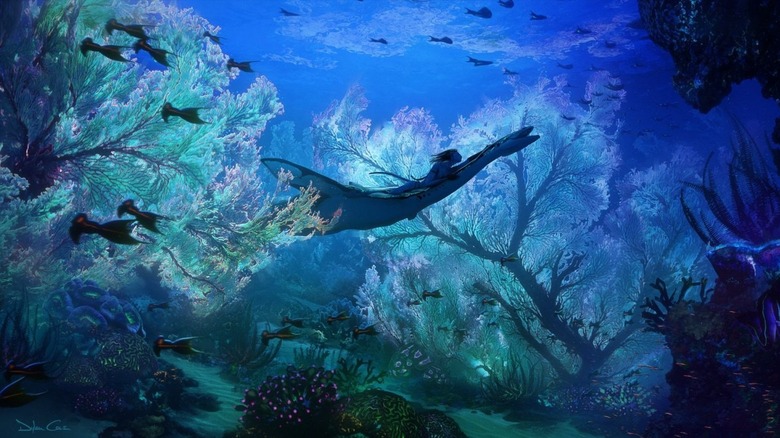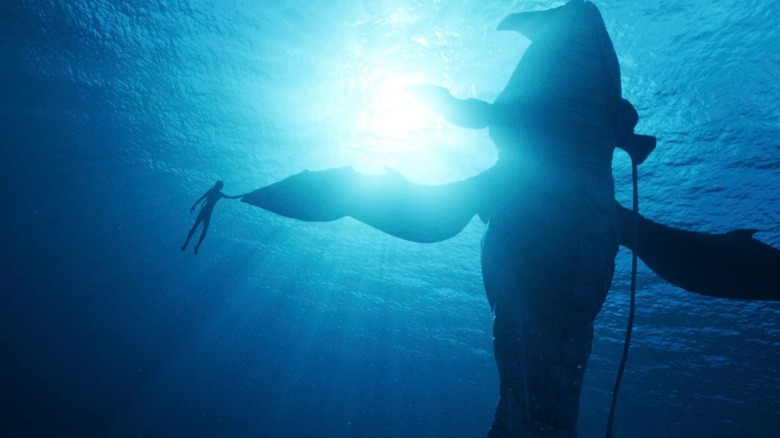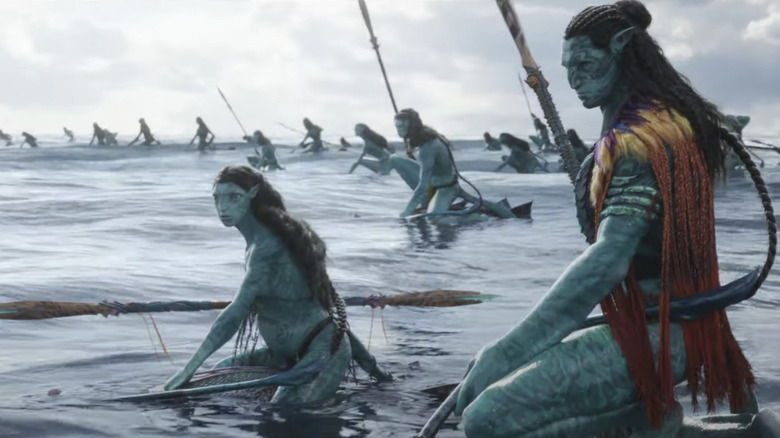Avatar: The Way Of Water Is At Its Best When It's Just About The Alien Fish
This post contains spoilers for "Avatar: The Way of Water."
James Cameron spent as much time making "Avatar: The Way of Water" as Axl Rose took to make "Chinese Democracy." Cameron was so keen to make his film in a very particular way, that he waited 13 years for film technology to catch up to his way of thinking. Importantly, Cameron wanted "The Way of Water" to take place, well, largely underwater, with his Na'vi characters freely swimming through the crystal-clear waters of Pandora. Since the Na'vi characters were all visualized using complex motion capture technology, the actors in "Water" were filmed in a large pool, having to act while holding their breath.
Cameron then transposed the underwater Na'vi characters into one of the most dazzlingly realized artificial environments yet seen on the big screen. However one may feel about the story or the characters of "The Way of Water," it's difficult not to be astounded by the lagoons of Pandora's blissful archipelagos. About a third of the way into "Water," the Na'vi children swim around for quite a long time, taking a break from the plot and enjoying their new environment. The kids swim through a gorgeous, diverse biome full of small fish, strange coral, massive eels, rideable plesiosaurs, and myriad other unnamed undersea creatures. The sands are white and clean and tactile. With a little imagination, even the warm temperature can be felt.
The sequence is so breathtaking, a viewer might get the impression that the hour of "Avatar" that preceded it was mere filler. Cameron's heart belongs to these oceans — he is famously an oceanography nut — and it's likely he backward engineered an "Avatar" movie for the mere purpose of the film's underwater sequences. Characters, conflict, and action were, one might postulate, an afterthought.
Super whales
A central sequence of "The Way of Water" also involves the terrifyingly convincing creation of a massive intelligent alien super-whale that the character of Lo'ak (Britain Dalton) befriends. Lo'ak finds himself in a distant sea, far from the Na'vi village, when he is attacked by a vicious outsized coelacanth. Just when it looks like the beast will eat our hero, a whale speeds by and knocks the attacker into a wall of coral. Instantly, viewers trust whales.
The whales in "Water" can communicate through a spoken language of clicks, and their dialogue is subtitled. They also occasionally sport enormous tattoos. The whales live in fear of visiting humans, however, as a team of vicious whalers has been patrolling the seas. The whales are, in the old sense of the word, awesome.
Despite advances in special effects technology, filmmakers seem to struggle with a sense of scale. Too few modern effects-based movies take the time to look out into a grand vista, or to appreciate the wild world in which they take place. Characters are often too cool for school, rarely stopping to express awe and wonderment. If, for instance, one of the Guardians of the Galaxy met a Godzilla-sized monster, they would likely roll their eyes and whip out a gun. Nothing can astonish modern day superheroes, and, by extension, modern audiences.
Cameron is perfectly happy to animate his imaginary animals with utter enormity. The 3-D also helps establish a sense of depth. When, at the film's climax, a whale attacks a military vessel in an amusing anti-homage to "Free Willy" ... well, at least one critic in the theater was laughing like a goon.
The artificial natural world
The irony of the "Avatar" movies is, of course, that Cameron required the most advanced, complicated filmmaking technologies available in order to create his ideal natural world. With Pandora, Cameron is clearly attempting to make his own Garden of Eden. Human greed, human military thinking, and just humanity in general is the Serpent. Rather than find a real place, however, and populate it with humans, Cameron builds his Eden from the ground up, gives it over to a species of blue-skinned non-humans.
One might say that Cameron, in spending so much attention to his undersea vision, is in a constant state of longing for a simpler, cleaner world. While Cameron is a master of mechanical filmmaking, machines have often been depicted as wicked or powerless in his films. In his "Terminator" movies, the villain is an evil robot from the future, a future where evil machines have taken over the Earth. In "Aliens," a team of dumb Marines have faith in their weapons and machines, only to be haplessly slaughtered by extraterrestrial humanoid bone insects. And what is the S.S. Titanic but humankind's most potent symbol for hubris after the Tower of Babel?
In the "Avatar" movies, the Na'vi are equipped with psychic tendrils that allow them to bond with plants, animals, and even the very core of the planet. It's said several times throughout that the energy matrix that runs through the entire planet has something that might be called a consciousness. In Cameron's ideal world, the goddess Gaia is a physical being.
Cameron's films may be often action fantasies with silly stories and/or shallow characters, but for multiple sustained moments, audiences can at least pretend what it's like to swim around in Paradise.


